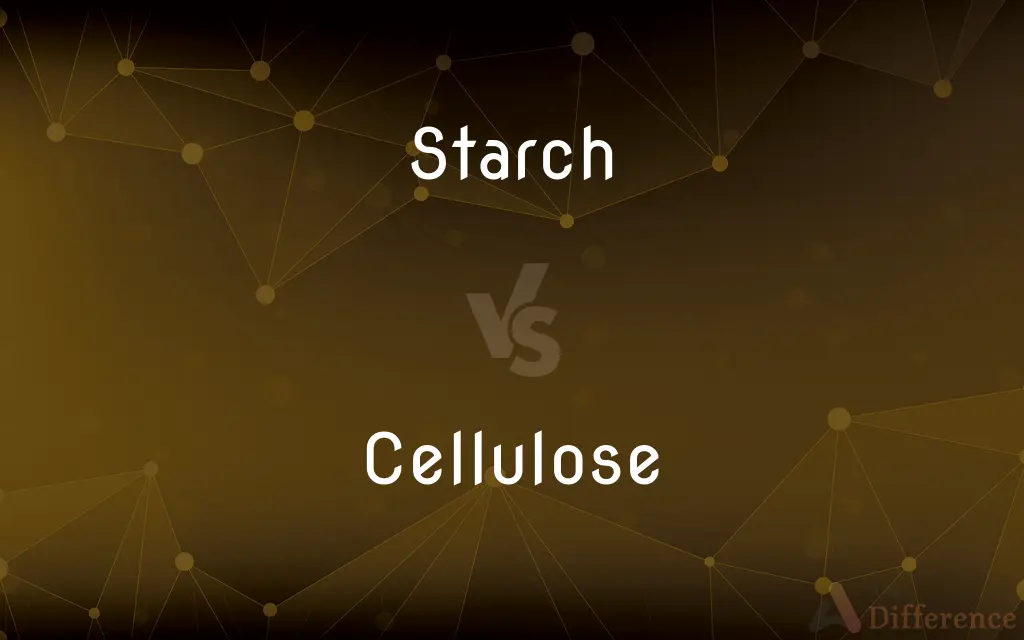Starch vs. Cellulose — What's the Difference?
By Maham Liaqat & Fiza Rafique — Updated on April 18, 2024
Starch is a digestible polysaccharide made from alpha-glucose units, primarily used for energy storage in plants; cellulose, consisting of beta-glucose, forms plant cell walls and is indigestible by humans.

Difference Between Starch and Cellulose
Table of Contents
ADVERTISEMENT
Key Differences
Starch is primarily found in seeds, roots, and tubers of plants, serving as an energy reserve. Whereas cellulose is a major structural component of plant cell walls, providing rigidity and strength to plants.
Starch molecules are organized in a helical structure, which is relatively easy for enzymes to break down during digestion. On the other hand, cellulose has a straight, rigid structure due to beta-1,4 glycosidic bonds, making it resistant to human digestive enzymes.
Humans can digest starch by enzymatic processes that break down its alpha-glucose bonds, converting it into energy. Whereas cellulose remains largely undigested in humans, acting instead as dietary fiber that aids in the digestive process.
Starch is used extensively in the food industry as a thickener, binder, and stabilizer. Conversely, cellulose finds use in the production of paper, textiles, and as a food additive to provide texture and fiber.
In terms of chemical composition, both starch and cellulose are polymers of glucose. However, the orientation of the glucose units differs, with starch consisting of alpha-glucose and cellulose consisting of beta-glucose.
ADVERTISEMENT
Comparison Chart
Basic unit
Alpha-glucose
Beta-glucose
Bond type
Alpha-1,4 and alpha-1,6 glycosidic bonds
Beta-1,4 glycosidic bonds
Structure
Helical
Linear and rigid
Digestibility
Digestible by humans
Not digestible by humans
Primary Use
Energy storage in plants, food industry
Structural component in plants, paper, textiles
Compare with Definitions
Starch
Biochemically broken down into glucose by human enzymes.
Amylase in saliva starts the breakdown of starch into simpler sugars.
Cellulose
Composed of beta-glucose units making it tough and insoluble.
The beta-1,4 bonds in cellulose create a rigid structure.
Starch
A carbohydrate polymer consisting of numerous glucose units joined by glycosidic bonds.
Potatoes and rice are rich sources of starch.
Cellulose
Used industrially in the production of paper and textiles.
Cotton, a pure form of cellulose, is used extensively in the textile industry.
Starch
Utilized as an energy reserve in various plants.
Starch is stored in the form of granules in plant tissues.
Cellulose
Also used as an additive in food to add texture and bulk.
Cellulose is added to shredded cheese to prevent clumping.
Starch
Commercially used as a thickening agent in cooking.
Cornstarch is often used to thicken sauces and gravies.
Cellulose
A complex carbohydrate that forms the structural component of the plant cell wall.
Cellulose fibers are what make plant stems, leaves, and branches strong.
Starch
Exists in two forms: amylose and amylopectin.
Amylose is primarily responsible for the gelatinization of starch during heating.
Cellulose
Not digestible by humans, used as a dietary fiber.
Cellulose passes through the human digestive system largely intact.
Starch
Starch or amylum is a polymeric carbohydrate consisting of numerous glucose units joined by glycosidic bonds. This polysaccharide is produced by most green plants for energy storage.
Cellulose
Cellulose is an organic compound with the formula (C6H10O5)n, a polysaccharide consisting of a linear chain of several hundred to many thousands of β(1→4) linked D-glucose units. Cellulose is an important structural component of the primary cell wall of green plants, many forms of algae and the oomycetes.
Starch
An odourless, tasteless white substance occurring widely in plant tissue and obtained chiefly from cereals and potatoes. It is a polysaccharide which functions as a carbohydrate store and is an important constituent of the human diet.
Cellulose
A polysaccharide, (C6H10O5)n, that is composed of glucose monomers and is the main constituent of the cell walls of plants. It is used in the manufacture of numerous products, including paper, textiles, pharmaceuticals, and insulation.
Starch
Powder or spray made from starch and used before ironing to stiffen fabric or clothing
Crisp linen, stiff with starch
Cellulose
A complex carbohydrate that forms the main constituent of the cell wall in most plants and is important in the manufacture of numerous products, such as paper, textiles, pharmaceuticals, and explosives.
Starch
Stiffness of manner or character
The starch in her voice
Cellulose
(organic compound) A polysaccharide containing many glucose units in parallel chains.
Starch
Stiffen (fabric or clothing) with starch
Starch your collar to keep it straight and stiff
Cellulose
Consisting of, or containing, cells.
Starch
(of a boxer) defeat (an opponent) by a knockout
Ray Domenge starched Jeff Geddami in the first
Cellulose
Consisting of, or containing, cells.
Starch
A naturally abundant nutrient carbohydrate, (C6H10O5)n, found chiefly in the seeds, fruits, tubers, roots, and stem pith of plants, notably in corn, potatoes, wheat, and rice, and varying widely in appearance according to source but commonly prepared as a white amorphous tasteless powder.
Cellulose
The substance which constitutes the essential part of the solid framework of plants, of ordinary wood, cotton, linen, paper, etc. It is also found to a slight extent in certain animals, as the tunicates. It is a carbohydrate, (C6H10O5)n, isomeric with starch, and is convertible into starches and sugars by the action of heat and acids. When pure, it is a white amorphous mass. See Starch, Granulose, Lignin.
Unsized, well bleached linen paper is merely pure cellulose.
Starch
Any of various substances, such as natural starch, used to stiffen cloth, as in laundering.
Cellulose
A polysaccharide that is the chief constituent of all plant tissues and fibers
Starch
Starches Foods having a high content of starch, as rice, breads, and potatoes.
Starch
Stiff behavior
"Dobbs, the butler ... isn't as stiff as he used to be.
Ann, my brother's new wife, has loosened up his starch a bit" (Jennifer St. Giles).
Starch
Vigor; mettle
"Business travel can take the starch out of the most self-assured corporate titan" (Lisa Faye Kaplan).
Starch
To stiffen with starch.
Starch
(uncountable) A widely diffused vegetable substance, found especially in seeds, bulbs and tubers, as extracted (e.g. from potatoes, corn, rice, etc.) in the form of a white, glistening, granular or powdery substance, without taste or smell, and giving a very peculiar creaking sound when rubbed between the fingers. It is used as a food, in the production of commercial grape sugar, for stiffening linen in laundries, in making paste, etc.
Starch
Carbohydrates, as with grain and potato based foods.
Starch
(uncountable) A stiff, formal manner; formality.
Starch
(uncountable) Fortitude.
Starch
(countable) Any of various starch-like substances used as a laundry stiffener
Starch
To apply or treat with laundry starch, to create a hard, smooth surface.
She starched her blouses.
Starch
Stiff; precise; rigid.
Starch
Stiff; precise; rigid.
Starch
A widely diffused vegetable substance found especially in seeds, bulbs, and tubers, and extracted (as from potatoes, corn, rice, etc.) as a white, glistening, granular or powdery substance, without taste or smell, and giving a very peculiar creaking sound when rubbed between the fingers. It is used as a food, in the production of commercial grape sugar, for stiffening linen in laundries, in making paste, etc.
Starch
Fig.: A stiff, formal manner; formality.
Starch
To stiffen with starch.
Starch
A complex carbohydrate found chiefly in seeds, fruits, tubers, roots and stem pith of plants, notably in corn, potatoes, wheat, and rice; an important foodstuff and used otherwise especially in adhesives and as fillers and stiffeners for paper and textiles
Starch
Stiffen with starch;
Starch clothes
Common Curiosities
Can humans digest cellulose?
No, humans cannot digest cellulose due to its beta-1,4 glycosidic bonds.
What is starch?
Starch is a carbohydrate polymer that plants use to store energy.
Why is starch important in the human diet?
Starch is a major source of energy, as it is easily broken down into glucose.
How does the structure of starch differ from cellulose?
Starch has a helical structure due to alpha-glucose units, while cellulose has a linear and rigid structure.
What is cellulose?
Cellulose is a carbohydrate polymer that constitutes the structural framework of plant cell walls.
How does cellulose benefit human health?
As dietary fiber, cellulose aids in digestion and helps prevent constipation.
What is the role of starch in plant seeds?
Starch provides energy necessary for seed germination and early growth.
How does cellulose impact the texture of food products?
As an additive, cellulose can increase fiber content and improve texture in processed foods.
Where is cellulose found besides plant cell walls?
Cellulose is also used to make paper, textiles, and as a food additive.
What are the industrial uses of starch?
Starch is used as a thickener, binder, and stabilizer in the food industry.
Are starch and cellulose similar in any way?
Both are polysaccharides made up of glucose units but differ in their glucose linkage.
What role does cellulose play in the environment?
Cellulose helps in maintaining the structure and rigidity of plants, which is crucial for their growth.
How do plants use starch?
Plants store starch in roots, seeds, and tubers for energy during dormancy or growth periods.
What makes cellulose indigestible to humans?
The beta-1,4 glycosidic bonds in cellulose cannot be broken down by human digestive enzymes.
Can starch be converted to other substances?
Yes, starch can be enzymatically converted to sugar and has applications in biofuel production.
Share Your Discovery

Previous Comparison
Scent vs. Flavour
Next Comparison
Cecum vs. AppendixAuthor Spotlight
Written by
Maham LiaqatCo-written by
Fiza RafiqueFiza Rafique is a skilled content writer at AskDifference.com, where she meticulously refines and enhances written pieces. Drawing from her vast editorial expertise, Fiza ensures clarity, accuracy, and precision in every article. Passionate about language, she continually seeks to elevate the quality of content for readers worldwide.














































